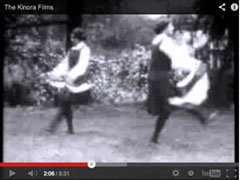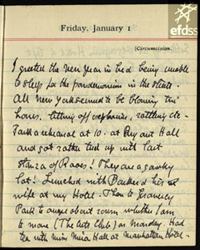 |
T A B L E O F C O N T E N T S
J U L Y / A U G U S T 2 0 1 3
Volume 19, Number 7/8
doi:10.1045/july2013-contents
ISSN: 1082-9873
E D I T O R I A L
Summer Issue
by Laurence Lannom, Corporation for National Research Initiatives
A R T I C L E S
Rethinking the Digital Media Library for RIT's The Wallace Center
Article by April Younglove, Rochester Institute of Technology
Abstract: In 2012, the Digital Preservation Team at Rochester Institute of Technology's The Wallace Center undertook an assessment of its Institutional Repository, the Digital Media Library. The Digital Preservation Team looked at the repository's current performance and requirements for ensuring its future success, and then examined four different philosophical approaches to configuring an IR that are in use by research institutions today: All-in-one, Archival, Researcher-centric and Subject. The team also compared open source vs. in-house repository providers and services including DSpace, Digital Commons, IR+, and Discovery Garden. A decision was made to move from the open source software DSpace to the full-service hosted software bepress from Digital Commons. The new repository will have a narrower research focus and will be rebranded RIT Scholar Works. It will be launched in fall of 2013. This article describes the configuration approaches that were considered and how each approach would impact the Digital Media Library, leading to the final recommendation.
Using Data Curation Profiles to Design the Datastar Dataset Registry
Article by Sarah J. Wright, Wendy A. Kozlowski, Dianne Dietrich, Huda J. Khan and Gail S. Steinhart, Cornell University; Leslie McIntosh, Washington University School of Medicine
Abstract: The development of research data services in academic libraries is a topic of concern to many. Cornell University Library's efforts in this area include the Datastar research data registry project. In order to ensure that Datastar development decisions were driven by real user needs, we interviewed researchers and created Data Curation Profiles (DCPs). Researchers supported providing public descriptions of their datasets; attitudes toward dataset citation, provenance, versioning, and domain specific standards for metadata also helped to guide development. These findings, as well as considerations for the use of this particular method for developing research data services in libraries are discussed in detail.
Drawing the Blueprint As We Build: Setting Up a Library-based Copyright and Permissions Service for MOOCs
Article by Lauren Fowler and Kevin Smith, Duke University Libraries
Abstract: The rapid growth of Massively Open Online Courses (MOOCs) in higher education has raised the question of what services libraries on campus can, and should, provide for these courses. One area in which librarians are frequently the source of advice and assistance is in providing copyright education and obtaining permissions to use copyrighted material, and there is now a pressing need to address those areas for MOOCs. This article describes the creation of a copyright and permissions service for MOOC instructors within the Duke University Libraries. Although the service has not been free of difficulties, and its success in actually obtaining permission for desired uses has been uneven, overall the response from faculty has been positive, and the libraries believe that this service is a fruitful and sensible way for them to support the MOOC phenomenon.
Model-Oriented Information Organization: Part 1, The Entity-Event Fabric
Article by Robert B. Allen, University of Tsukuba, Japan
Abstract: With rapidly growing interconnected collections of cultural materials, we need new approaches to information organization. We propose that schematic models which describe the content of documents rather than descriptions about the documents are the key for this new generation of descriptive systems. We explore process-oriented models implemented with linguistic frames as an approach to organizing a collection of rich content such as descriptions of history. We show how linguistic frames can implement the state-change model and how those frames might be applied to the organization of content such as history texts and complex materials such as historical newspapers. We focus on verb frames because we base our approach on state changes in entities which are described with verbs. We propose that systems of information organization for rich content such as historical texts be based on a "fabric" of entities and events. For instance, we describe incorporating into the fabric complex entities such as those with multiple parts. We also describe disaggregating complex events with sequences of related events which we call flows, as well as propose a flexible approach to grouping events and a schematic description of people including their mental states. Our approach is a companion to the original content and explicitly allows for versioning, metadata, and hierarchies of entity classes, as well as partonomies, functionality and instances. While our focus here is on history, the structures we define should be able to be applied across a variety of fields and they should be useful as targets for text mining. In a subsequent paper, we extend the fabric to use discourse elements to describe the relationships among events.
Model-Oriented Information Organization: Part 2, Discourse Relationships
Article by Robert B. Allen, University of Tsukuba, Japan
Abstract: In Part 1 of this 2-paper series, we proposed developing a fabric of entities and events. In order to apply that fabric to rich content describing history we also need to consider discourse relationships. Here, we first examine binary discourse relationships such as causation, generalization, and conditionals. We then consider more complex discourse relationships such as narrative, exposition, and argumentation as well as the role of evidence. Initial applications would support interaction with relatively constrained well-defined content. Eventually, a common-format, open-access, and open-source repository based on the standards we have described here could be developed. Moreover, because our approach combines event descriptions with discourse relationships it may be possible to use it as the basis for highly interactive services and simulations.
N E W S & E V E N T S
In Brief: Short Items of Current Awareness
In the News: Recent Press Releases and Announcements
Clips & Pointers: Documents, Deadlines, Calls for Participation
Meetings, Conferences, Workshops: Calendar of Activities Associated with Digital Libraries Research and Technologies
|
 |
F E A T U R E D D I G I T A L
C O L L E C T I O N


Film from 1912, shot on a Kinora machine. The earliest known examples of English folk dance on film, featuring sisters Maud and Helen Karpeles, Cecil Sharp and George Butterworth.
[Courtesy of the English Folk Dance and Song Society. Used with permission.]

Page 18 of Cecil Sharp's diary dated January 1, 1915.
[Courtesy of the English Folk Dance and Song Society. Used with permission.]
The Full English, a digital archive that allows anyone anywhere in the world to explore traditional English folk music and dance tunes, has been launched by the English Folk Dance and Song Society (EFDSS). Created in partnership with leading academic institutions, The Full English brings together 12 major collections for the first time in the most comprehensive, free, searchable digital archive of English folk songs, tunes, dances and customs in the world.
In a marriage between tradition and new media, more than 58,400 items from some of the country's most important folk music collections — including manuscripts, notes and letters — are conserved and digitised before being uploaded to a central digital archive. Users can browse through the collections of Harry Albino, Lucy Broadwood, Clive Carey, Percy Grainger, Maud Karpeles, Frank Kidson, Thomas Fairman Ordish, Frank Sidgwick, Cecil Sharp, Ralph Vaughan Williams, Alfred Williams and Mary Leather.
The online archive is searchable for free using the song or tune title, people's names, places, the collectors, and by using unifying numbers such as Roud numbers to find songs and music. It is hoped that further collections will be added in the future.
The Full English was made possible largely due to a £585,400 grant from the Heritage Lottery Fund (HLF). It also received support from the National Folk Music Fund, whose funding is given in memory of Ursula Vaughan Williams, and The Folklore Society.
EFDSS has worked in partnership with Clare College, The British Library, The Folklore Society, the Grainger Museum at The University of Melbourne, The Mitchell Library, the Vaughan Williams Memorial Library, and the Wiltshire and Swindon History Centre to amalgamate collections that are housed across the country.
D - L I B E D I T O R I A L S T A F F
Laurence Lannom, Editor-in-Chief
Allison Powell, Associate Editor
Catherine Rey, Managing Editor
Bonita Wilson, Contributing Editor
|